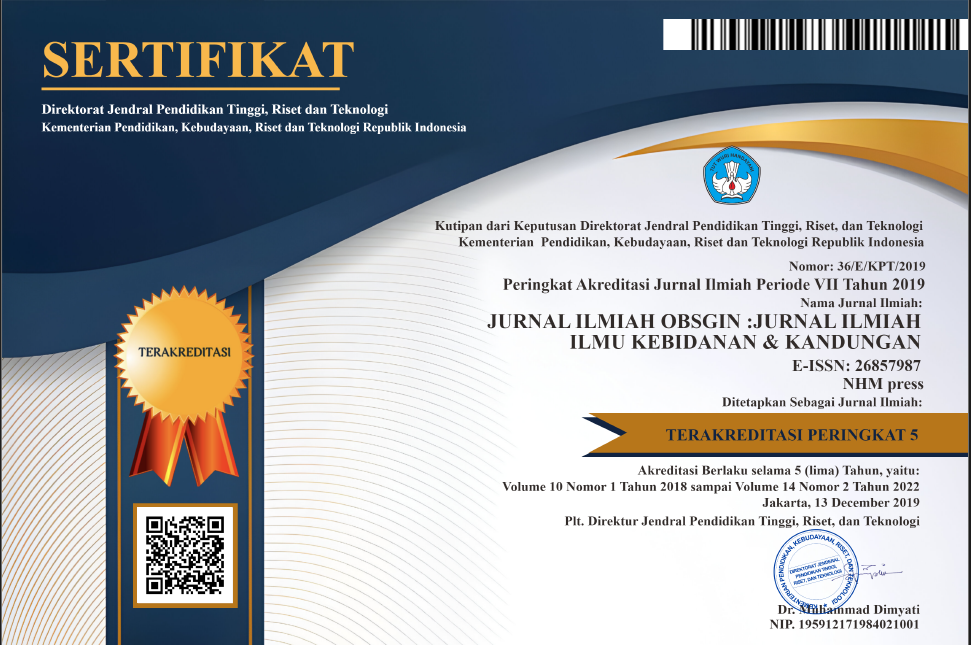Hubungan Kecemasan Ibu Dengan Kesediaan Melakukan Imunisasi DPT Combo DI Wilayah Kerja Puskesmas Pembantu Ranuwurung Lumajang
Abstract
Combination immunization multivalent diphtheria, pertussis, and tetanus (DPT) combination immunization is the basis of many childhood programs around the world. maintaining the acceptance and absorption of the DPT combination vaccine is paramount, given its benefits in protecting against various diseases in the community. This study aims to to identify the relationship between maternal anxiety and willingness to do DPT Combo at Ranuwurung Health Center, Lumajang. Research design using correlation with cross sectional approach. The population of this study consisted of 58 mothers with young children who were to participate in the DPT Combo at the Ranuwurung Health Center in Lumajang. Simple Random Sampling is the method of sampling that is employed. Data were collected using a state anxiety inventory (STAI) questionnaire and willingness to receive vaccines. data analysis using Predictive Analytics SoftWare Version 18 with the spearman rho test at a significance level of <0.05. The results showed that more than half (56.9%) of mothers with children who were to be immunized with DPT had moderate levels of anxiety and almost half (43.1%) had a willingness to do well. the results of statistical analysis showed that anxiety significantly indicated the willingness to do the DPT Combo exercise at a moderate correlation level (p-value = 0.001; r = 0.438). Continued education, health promotion, and encouragement to help families comprehend are suggested. Families where the mother and child reside ultimately voluntarily accept the DPT combination immunization
References
Baumgaertner. (2020). Risk of disease and willingness to vaccinate in the United States: a population-based survey. Plos One Journal, 17(10).
Baumgaertner, & Ridenhour. (2020). Risk of disease and willingness to vaccinate in the United States: a population based survey. Plos One Journal, 17(10).
Boscart, & Fernie. (2012). Using psychological theory to inform methods to optimize the implementation of a hand hygiene intervention. Implement Science, 7(1).
Chen, Yanjun, Chen, WEn, & Feng. (2021). An online survey of the attitude and willingness of Chinese adults to receive COVID-19 vaccination. Human Vaccines & Immunotherapeutics, 10(1080).
Collange. (2016). General practitioners’ attitudes and behaviors toward HPV vaccination. French National Survey, 6(762).
Dennis. (2018). Peer support within a health care context: a concept analysis. International Journal Nursing Study, 40(3).
Domenech. (2019). Duration of Immunity and Effectiveness of Diphtheria Tetanus–Acellular Pertussis Vaccines in Children. Jama Network Open, 6(34).
Dube. (2016). . Understanding vaccine hesitancy in Canada: results of a consultation study by the Canadian Immunization Research Network. Plos One Journal, 11(1).
Ejaz, B., & Muazzam. (2020). Measuring the Scale and Scope of Social Anxiety among Students in Pakistani Higher Education Institutions: An Alternative Social Anxiety Scale. Psychology of Sustainability and Sustainable Development, 12(6).
Greifenender, & Bless. (2018). Social Cognition How Individuals Construct Social 2nd Edition. Routledge.
Hidayat. (2020). Ilmu Perilaku Manusia: Pengantar Psikologi Untuk Tenaga Kesehatan. Gramedia Pustaka Utama.
Kementerian Kesehatan RI. (2019). Profil Kesehatan Indonesia 2018. Sekretariat Jendral Kementerian Kesehatan RI. http://www.depkes.go.id/resources/download/pusdatin/profil-kesehatan-indonesia/Data-dan-Informasi_Profil-Kesehatan-Indonesia-2018.pdf
Kim, Taylor, & Gutter. (2016). Extended Families: Support, Socialization, and Stress. Family and Consumers Science Journal, 1(1).
Maramis, W. F., & Maramis, A. A. (2018). Catatan Ilmu Kedokteran Jiwa. Airlangga University Press.
Moghaddam, Maryam, & Seraji. (2021). The protection motivation theory for predict intention of COVID-19 vaccination in Iran: a structural equation modeling approach. BMC Public Health, 21(1165).
Okubo, & Yoshioka. (2021). COVID-19 vaccine hesitancy and its associated factors in Japan. Vaccines, 9(6).
Saedi, & Safaei. (2021). Prevalence of Depression, Anxiety and Stress among Patients Discharged from Critical Care Units. The Journal of Critical Care Medicine, 7(2).
Stepanek, & Janosikova. (2021). Motivation to COVID-19 Vaccination and Reasons for Hesitancy in Employees of a Czech Tertiary Care Hospital: A Cross-Sectional Survey. MDPI Journal, 9(863).
Stuart, & Sundeen’s. (2016). Prinsip Dan Praktik Keperawatan Kesehatan Jiwa Stuart Edisi Indonesia (B. Keliat (ed.)). Elsevier.
Wang. (2017). A review of Haemophilus influenzae disease in Europe from 2000-2014: chal- lenges, successes and the contribution of hexavalent combination vaccines. Expert Rev Vaccines, 16(17).
Wang, Eong, Ho, & Cheung. (2021). Change of Willingness to Accept COVID-19 Vaccine and Reasons of Vaccine Hesitancy of Working People at Different Waves of Local Epidemic in Hong Kong, China: Repeated Cross-Sectional Surveys. MDPI Journal, 9(1).
Wuryaningsih, E. W., Windarwati, H. D., Ikhtiarini, E., Deviantony, F., & Kurniyawan, E. H. (2018). Buku Ajar Keperawatan Kesehatan Jiwa 1. UPT Percetakan dan Penerbitan Universitas Jember.
Yu, & Geldsetzer. (2021). Knowledge About COVID-19 Among Adults in China: Cross sectional Online Survey. Journal of Medical Internet Research, 23(4).
Zollner. (2015). The value of childhood combination vaccines: from beliefs to evidence. Human Vaccin Immunotherapy, 11(9).












